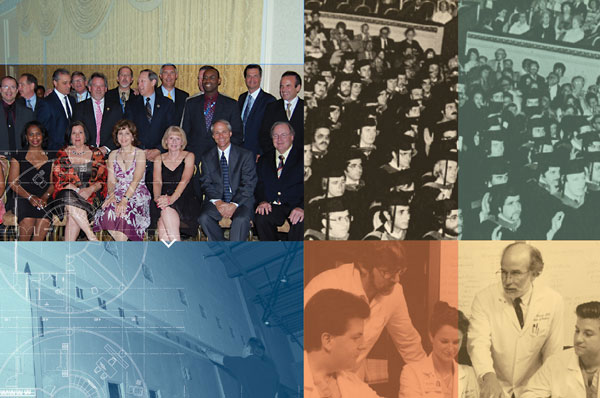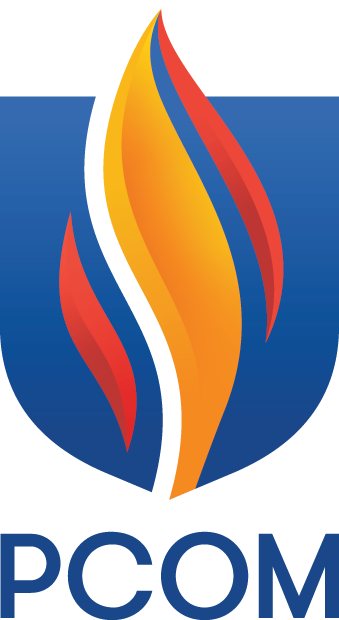A New Framework for Engagement
Unifying the PCOM Alumni Association
September 12, 2016By Nancy West
In January, following three years of intensive study and discussion, the PCOM Alumni
Association Board of Directors approved a new organizational structure for the Association
that will provide greater benefits for alumni, students and the College.
The journey toward this new structure began in 2013 during a strategic plan review,
led by past Alumni Association president Hal S. Bendit, DO ’84. The Alumni Association
Board of Directors began discussions about the role and engagement of the Board and
what the Association could and should be doing to support both the College and current
students. During these discussions, it became clear that many alumni were confused
about the entity to which they were making donations, since they received solicitations
from both the Alumni Association and the College. As discussions continued, it was
also evident that while the Association did spend donations it received on supporting
the College and students, significant dollars were also being spent on maintenance
of the separate organizations, including insurance and accounting services.
Alumni Survey Highlights
Institutional Advancement recently conducted a survey of alumni from all programs
nationwide for use by the PCOM Alumni Association in developing future initiatives.
More than 1,000 responses were received overall. Following are a few highlights of
the survey findings:*
*Not all respondents answered every question. Percentages relate to those alumni who
responded to each particular question mentioned.
The Board voted unanimously to approve the dissolution of the Alumni Association as
a separate organization and the integration of the Association as a department of
the College as of July 1, 2016. “It became clear that a smaller, more nimble core
Board would be better suited to respond to the needs of our alumni and students,”
says Dr. Bendit. “In merging with the College, who already supported our efforts through
Institutional Advancement, we felt that we could better achieve our goals together
versus working as two distinct organizations.”
“With this structure, alumni will know exactly who they are making donations to and
what those donations are being used for,” says Dana Shaffer, DO ’85, past president
of the Alumni Association during the time of this merger. “Further, the Association
Board will have better direction about the things we can and should be doing for the
alumni, students and the College.”
In deciding on this new structure, the Association’s Executive Committee spent many
hours reviewing bylaw provisions and types of association structures. “Most Association
members belong to other alumni associations from undergraduate schools, so they researched
how they are organized and shared that information,” notes Dr. Shaffer. It was found
that the new Alumni Association model is far more prevalent than the previous one.
The entire Association Board was guided by the book Race for Relevance, by Harrison
Coerver and Mary Byers, both experts in association management. “This book is being
widely read and used by many osteopathic association boards of directors, and it was
helpful to us in recognizing the changes we needed to make to become a more effective
and responsive organization,” relates Dr. Shaffer.
After discussing the book, the Executive Committee took input from the Association
Board about what the organization could and should do. Based on the Board’s extensive
comments, the Committee drafted bylaws to incorporate all those thoughts.
Carrie Collins, JD, chief advancement officer, also served as a resource in developing this new organization to meet more of the
ongoing fundraising needs the College will have.
“During the process, we tried to listen and take into account everyone’s concerns,”
notes Dr. Shaffer. “We had ongoing discussion and consensus building, and we tried
to incorporate minority opinions in the final document.
“In this new paradigm, we wanted to make the Alumni Association Board of Directors
a lot more inclusive of all programs—graduate as well as osteopathic,” he emphasizes.
“Our College has diversified with our current programs, and it is important to incorporate
all the disciplines to be more involved with the alumni base,” says Darlene Dunay,
DO ’83, past president of the Alumni Association, who, during her tenure, oversaw
bylaw changes in preparation for the merger.
The new bylaws created a set of Alumni Councils to support all alumni and students
from all graduate degree programs on both campuses. This will result in increased
Board outreach to alumni and students, creating better programs and services for all.
Four councils were designated, each with representatives from their own specific groups:
- The Executive Council runs the business of the association, with responsibility for
finances, budgeting and administration;
- The DO Council is responsible for activities and functions related to DO alumni;
- The Professional Careers Council is responsible to all graduate degree program alumni
except DO; and
- The Trainee Council is responsible for all student and resident activities and functions.
“In the past, 95 percent of our discussions at Association Board meetings were related
to the DO program, even though we tried to include members from the other graduate
degree programs,” relates Dr. Shaffer. “Now the individual Councils can discuss and
do work that is appropriate for their particular graduate programs, such as mentoring
students, raising money and scholarships for each graduate degree program and providing
social events for students in those programs.”
 In January, the PCOM Alumni Association Board of Directors approved a new organizational
structure that will provide greater benefits for alumni, students and the College.
In January, the PCOM Alumni Association Board of Directors approved a new organizational
structure that will provide greater benefits for alumni, students and the College.
The Councils first met individually at the Alumni Association’s semi-annual Board
meeting in June 2016; they will meet during Board meetings twice a year. “When the
Councils meet, they address their own agenda items, then come back together as an
entire group to share ideas and report what they would like to do,” explains Dr. Shaffer.
Under the new structure, the Councils seek input from Institutional Advancement when
they want to plan an activity that requires financial resources. Then they present
the idea to the entire Association Board, who decides how it would best be accomplished.
“This structure will allow the Alumni Association to be more visible and supportive
of what alumni do—a greater benefit to the alumni, students and the College,” says
Jay S. Feldstein, DO ’81, president and chief executive officer. “We believe the new
structure will facilitate stronger communication with the alumni. I applaud the efforts
of our Association in developing such an effective new organization.”
The Alumni Association has moved its assets of approximately $694,000 to a newly created
endowed fund called the Alumni Association Endowed Activities Fund, which will be
managed by the College with the institution’s other donor-funded endowments. Income
from the endowment will be used to support the College, and the Alumni Association
Board of Directors will make recommendations for its use. In the past, for example,
the Association donated $100,000 to each of the Philadelphia and Georgia Campuses
for their clinical learning and assessment centers. Recently, $35,000 was donated
for renovation of one of the College’s clinics in western Pennsylvania.
“These donations are also helpful to Institutional Advancement staff when they meet
with donors,” explains Dr. Shaffer. “Staff can point out that our Alumni Association
has already donated to a project or program, which encourages others to donate as
well.”
Any future gifts made in support of the Alumni Association, will be added to the principal
of the endowed fund. In addition, a new operating budget for the Association will
be funded by the College for travel expenses and awards.
“This structure enables the Alumni Association to focus more on its mission, which
is helping students and alumni, because they no longer have to be concerned with the
business aspects of running the association,” says Pamela Ruoff, MS, executive director,
alumni engagement.
“The greatest advantage of the new Association structure is the creation of a better
network between students and alumni,” adds Dr. Dunay.
In addition to scholarships, financial support, social events and other programs offered
in the past, the Alumni Association hopes to provide more programs and services in
the future, including:
- More volunteer opportunities for alumni to provide mentoring for students, speak to
student clubs and give guest lectures in the classroom. With 65 student clubs and
organizations, there is no shortage of ways that alumni can provide advice and guidance
to their future colleagues.
- Better ways for alumni to connect with each other online through new technology. An
increased desire of alumni to stay connected with one another outside of alumni events
has prompted Institutional Advancement to begin investigating various software and
online applications for communication.
- Continuing education panel discussions with an integrated healthcare focus. The Professional
Careers Council has suggested CE panel discussions that would appeal to health professionals
in various fields.
- The opportunity to learn a foreign language through Mango Languages at no cost to
alumni through the PCOM Library portal.
- Fundraising initiatives to benefit the Alumni Association Endowed Activities Fund.
Alumni who are interested in volunteering can contact Marianne Mancini, director,
alumni engagement, at 215-871-6121 or mariannema@pcom.edu.
“Our main objective is to make the Alumni Association a more efficient organization
that is responsive to all alumni and students, and one they can feel proud to belong
to,” concludes Dr. Shaffer.
History of the PCOM Alumni Association
On September 8, 1902, graduates of the first classes of Philadelphia College and Infirmary
of Osteopathy (PCIO), which would later become known as Philadelphia College of Osteopathic
Medicine (PCOM), held a meeting with the idea “to promote the prosperity and extend
the influence of Alumni and their Alma Mater, and to encourage a high standard of
Osteopathic education and practice.” At that meeting, they formed the Alumni Association
and elected officers.
1916
The Alumni Association established a drive for funds for the College, and began raising
money annually for the College’s general fund.
1949
The Association officially incorporated in the State of New Jersey as a non-profit
corporation, managed by a representation of a regional group of alumni to serve as
officers and members of the Board of Directors.
1963
The Alumni Affairs Office was established on campus.
1983
The Association incorporated in the Commonwealth of Pennsylvania, giving it an increased
role in providing financial support for education by starting programs such as the
Alumni Student Loan Fund.
1984
The Association gained official representation on the PCOM Boards of Trustees.
2010
Representatives from all graduate degree programs and the student body of the Philadelphia
and Georgia campuses were added to the Association Board.
2016
The Alumni Association Board of Directors voted unanimously to merge with PCOM as
of July 1, 2016, thus dissolving their 501(c)(3) status. New bylaws created Alumni
Councils to represent and support all alumni and students from all graduate degree
programs on both campuses. This merger will enable the Alumni Association to fulfill
its mission of promoting the interest and welfare of PCOM, and cultivating communication
and relationships among all graduates, students, administration, faculty and staff.
The Association will focus all of its efforts on engagement and outreach to both students
and alumni of all graduate degree programs.

 In January, the PCOM Alumni Association Board of Directors approved a new organizational
structure that will provide greater benefits for alumni, students and the College.
In January, the PCOM Alumni Association Board of Directors approved a new organizational
structure that will provide greater benefits for alumni, students and the College.